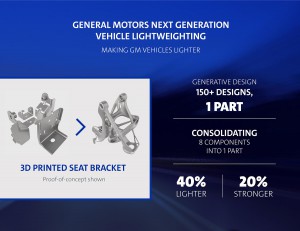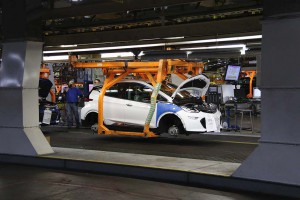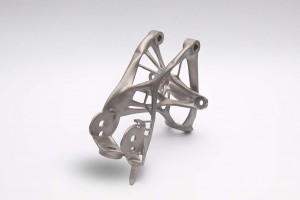Since the earliest days of the auto industry, manufacturers have stamped, forged, cast and molded most of the parts that go into their products, but the search for lighter cars and trucks is forcing them to search for alternative approaches.
Working with the software company Autodesk, General Motors is exploring the potential of using additive manufacturing, also known as 3D printing, and may introduce the technology on one of the more than 20 new battery-electric and hydrogen fuel-cell vehicles it plans to bring to market over the next five years. And it isn’t alone. Niche manufacturers, such as Swedish hypercar company Koenigsegg, as well as major manufacturers BMW and Ford, are also exploring ways to utilize 3D printing.
“This disruptive technology provides tremendous advancements in how we can design and develop components for our future vehicles to make them lighter and more efficient, said GM Vice President Ken Kelzer, head of the automaker’s Global Vehicle Components and Subsystems.
(Mini using 3D printing to let customers personalize their cars. Click Here for more.)
The traditional approach to developing parts is one of time-consuming trial-and-error. Engineers work up a design then use relatively conventional methods to produce a prototype for testing. Autodesk’s AI software helps engineers come up with best-guess designs that minimize the new for real-world testing. And the designs can then be turned into real-world parts through the 3D printing process which builds them up one pixel at a time.
“GM engineers will be able to explore hundreds of ready-to-be-manufactured, high-performance design options faster than they were able to validate a single design the old way,” said Scott Reese, Autodesk Senior Vice President for Manufacturing and Construction Products.
Early versions of additive manufacturing were limited in the number of materials that can be used, such as epoxy liquids that would harden when blasted by a laser. But today, a wide range of plastics, metals and other materials can be utilized. GM, for example, was able to print a stainless steel seat bracket that, it says, is 40% lighter and 20% stronger than a conventional metal part. It also is a one-piece unit where the same bracket, using normal manufacturing techniques, would require eight components from several different suppliers.
That could simplify the manufacturing process while also cutting vehicle mass and, particularly with electrified vehicles, weight is the enemy of range and performance, so every ounce saved has an impact.
GM is currently validating the seat bracket and other 3D-printed parts and components that may wind up in production over the next few years as it starts expanding its electric vehicle portfolio. It has promised to bring at least two more models, on top of the current Chevrolet Bolt EV, to market by mid-2019, with as many as 20 more to follow by 2023.
 (Toyota setting up its own autonomous vehicle test center in Michigan. Click Here for the story.)
(Toyota setting up its own autonomous vehicle test center in Michigan. Click Here for the story.)
There are some downsides to 3D printing. The finished products aren’t necessarily as visually refined as parts and components produced by traditional methods, and there’s the issue of cost and production times. It can take minutes to create a piece that might be stamped out on a traditional metal press line in seconds. But by being able to produce complex parts, such as the seat bracket, which eliminate the need to bolt, glue or weld multiple parts together, the business case for 3D printing improves.
In some cases, the technology allows a carmaker to craft a part that might be difficult or impossible to produce any other way. Koenigsegg used 3D printing to produce the inner turbo housing for its Koenigsegg One:1 hypercar, for example. And the Williams Formula One team has relied on additive manufacturing so it can quickly replace or revise parts needed in its garage, before and even during a race.
GM rival Ford Motor Co. is also testing 3D printing for future mass production models. But start-up company Local Motors hopes to take things to the extreme. It has been working on a variety of different projects that could bring to market vehicles that are almost entirely made up of 3D-printed parts and components.
(Click Here to find out how an Israeli company could protect your car from a cyber-attack.)


